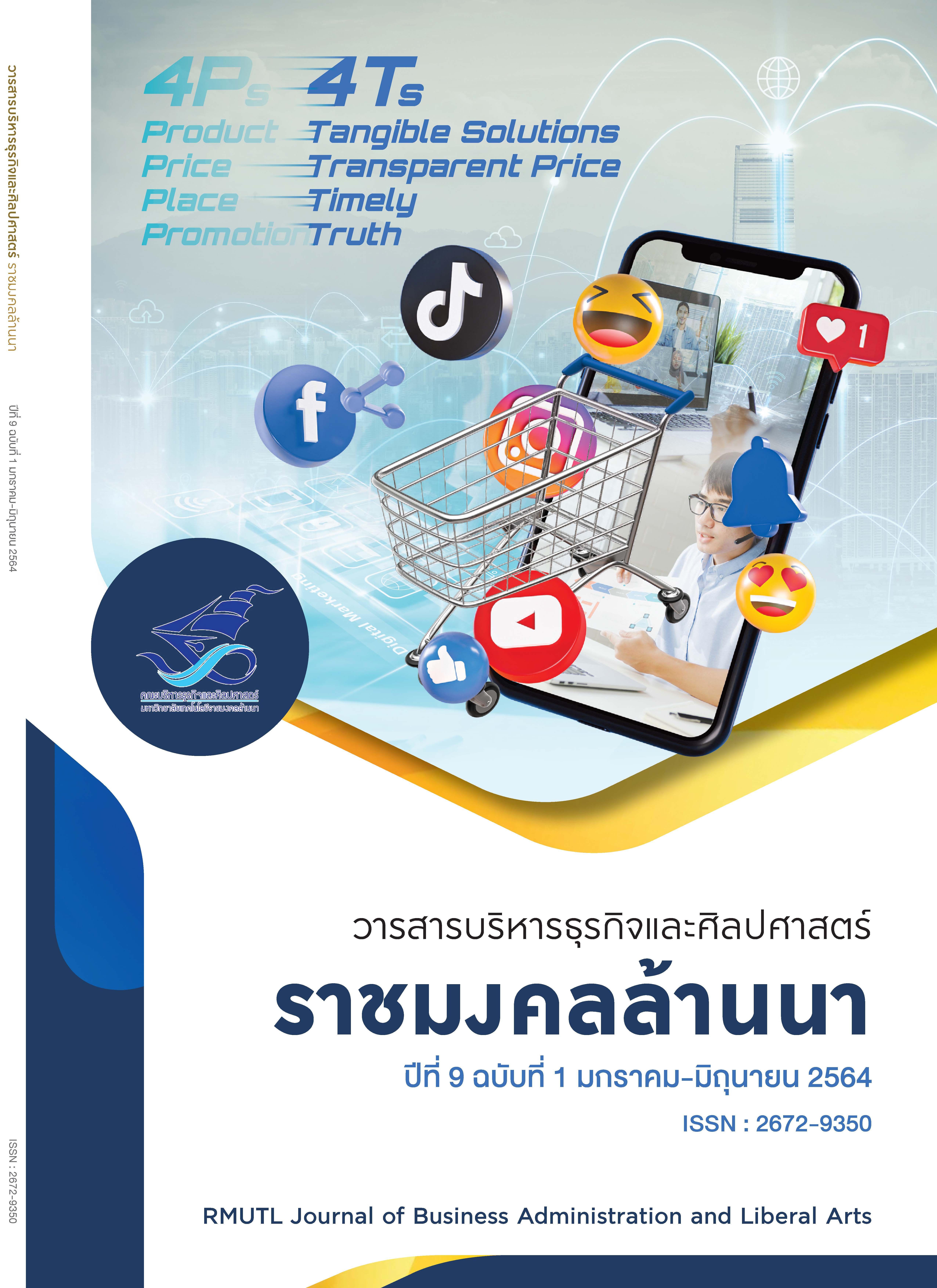The Shopping Behavior at 7-Eleven Convenience Stores of the Rajamangala University of Technology Lanna Nan Personnel
Main Article Content
Abstract
The purposes of this research were to (1) study the shopping behavior of personnel of Rajamangala University of Technology Lanna Nan at 7-Eleven convenience stores, (2) to study marketing mix factors affecting the decision of Rajamangala University of Technology Lanna Nan personnel to purchase products at 7-Eleven convenience stores. This quantitative research used the method of selecting all samples of 199 personnel from Rajamangala University of Technology Lanna Nan. The questionnaire was used as a research tool. The data were analyzed using frequency distribution statistics with the average percentage and standard deviation.
The results showed that the shopping behavior of the sample group revealed that most respondents were shopping for beverages on Monday–Friday. They tended to shop in convenience stores during 12.01–18.00 hours, with a 100–200 Baht per transaction. Purchasing frequency at convenience stores was 2–3 times a week, with most of them were shopping alone and taking less than 30 minutes. The reason for buying products from convenience stores was because the stores are located near their residences, and the primary purpose of choosing convenience stores is to buy products. The convenience store most frequently selected by the sample group is the Rajamangala branch. The marketing mix factors affecting the purchase decision of the product have shown that the distribution channel has the highest opinion by open for service at a convenient time, without holidays, and the location is convenient to visit. The second point is the marketing promotion, including sales promotion regularly such as price reduction, point accumulation, and product redemption. Modernity and diversity are vital factors for production. For the price factor, the price tag is clear and appropriate for the quality respectively.
Article Details
บทความวิจัยนี้เป็นของลิขสิทธิ์
References
กนกพร เนตรคำยวง และพัชราภรณ์ ลิมป์ยังอนันต์. (2559). พฤติกรรมและปัจจัยทางการตลาดที่มีผลต่อการเลือกใช้บริการร้านสะดวกซื้อ ในเขตอำเภอหางดง จังหวัดเชียงใหม่. วารสารวิชาการ การตลาดและการจัดการ มหาวิทยาลัยเทคโนโลยีราชมงคลธัญบุรี, 3(1): 52–53.
กองนโยบายและแผนงาน สำนักผังเมือง กรุงเทพมหานคร. (2559). รายงานการศึกษา: การค้าปลีก การค้าส่ง และการค้าปลีก–ค้าส่งขนาดใหญ่ ในกรุงเทพมหานครและปริมณฑล ปี พ.ศ. 2559. กรุงเทพฯ: สำนักผังเมือง.
กัลยา วาณิชย์บัญชา. (2551). การใช้ SPPS for Windows ในการวิเคราะห์ข้อมูล. (พิมพ์ครั้งที่ 11). กรุงเทพฯ: ธรรมสาร.
__________. (2557). การวิเคราะห์สถิติ: สถิติกการบริหารและวิจัย. กรุงเทพฯ: โรงพิมพ์แห่งจุฬาลงกรณ์มหาวิทยาลัย.
กาญจนา ยงค์เจริญชัย. (2554). ปัจจัยที่มีผลต่อการตัดสินใจซื้อสินค้าและบริการของผู้บริโภคร้านเซเว่น อีเลฟเว่น ในโรงพยาบาลในเขตกรุงเทพมหานคร. (ปริญญานิพนธ์บริหารธุรกิจมหาบัณฑิต). กรุงเทพฯ: สถาบันการจัดการปัญญาภิวัฒน์.
งานบุคลากร กองบริหารทรัพยากร. (2563). รายชื่อบุคลากร มทร.ล้านนา น่าน. จาก https://nan.rmutl .ac.th/page/งานบุคลากร
ชนาธิป ผลวรรณ์ และจิรวรรณ ดีประเสริฐ. (2557). พฤติกรรมการซื้อสินค้าและบริการของกลุ่มเบบี้บูมเมอร์ที่ร้านสะดวกซื้อในเขตกรุงเทพมหานคร. (การค้นคว้าอิสระ). จาก http://dspace.bu.ac.th/bit stream/thanakorn.pdf
ชัยสมพล ชาวประเสริฐ. (2553). การตลาดบริการ. กรุงเทพฯ: ซีเอ็ดยูเคชั่น.
ซีพีออลล์. (2563). ข้อมูลแผนที่. จาก https://www.7eleven.co.th/find-store
ดวงกมล ฐิติอักษรศิลปะ และศลิล วัชรพงษ์กิตติ. (2560). ปัจจัยส่วนประสมการตลาดที่มีผลต่อการซื้อสินค้าของผู้บริโภคในร้านเซเว่น อีเลฟเว่น ในเขตกรุงเทพมหานคร. วารสารบัณฑิตศึกษามหาวิทยาลัยราชภัฏสวนสุนันทา, 12(1): 52–53.
นภัทร ไตรเจตน์. (2559). ปัจจัยที่มีอิทธิพลต่อการตัดสินใจซื้อสินค้าจากร้านค้าปลีกแบบดั้งเดิม (ร้านโชห่วย) กรณีศึกษาในตลาดไท ปทุมธานี. (การค้นคว้าอิสระบริหารธุรกิจมหาบัณฑิต). กรุงเทพฯ: มหาวิทยาลัยกรุงเทพ.
พงษ์ ชัยชนะวิจิตร และคณะ. (2552). Lifestyle ของกลุ่ม Baby Boomers. วิทยาลัยการจัดการมหิดล. จาก http://inside.cm.mahidol.ac.th/mkt
พิษณุ อิ่มวิญญาณ. (2554). การจัดการร้านค้าปลีกที่มีอิทธิพลต่อพฤติกรรมการซื้อสินค้าของผู้บริโภค กรณีศึกษาร้านสะดวกซื้อในเขตกรุงเทพมหานคร. (ปริญญานิพนธ์บริหารธุรกิจมหาบัณฑิต). กรุงเทพฯ: มหาวิทยาลัยศรีนครินทรวิโรฒ.
พีระพงษ์ กิติเวชโภคาวัฒน์. (2551). ภาวการณ์เปลี่ยนแปลงของธุรกิจค้าปลีกในประเทศไทย. ศูนย์พัฒนาธุรกิจค้าปลีกและแฟรนไชส์สากล. กรุงเทพฯ: มหาวิทยาลัยศรีปทุม.
มาร์เก็ตเทียร์ออนไลน์. (2563). 1 ปีผ่านไป 7-ELEVEN ไปไกลแค่ไหน? ปี 2019 จะไปได้ไกลกว่า. (นิตยสารออนไลน์). จาก https://marketeeronline.com
ศิริวรรณ เสรีรัตน์ และคณะ. (2552). การบริหารการตลาดยุคใหม่. กรุงเทพฯ: ธรรมสาร.
ศิวารัตน์ ณ ปทุม และคณะ. (2550). พฤติกรรมผู้บริโภคชั้นสูง. กรุงเทพฯ: พิฆเณศพริ้นติ้ง.
ศูนย์วิจัยกสิกรไทย. (2556). วัฒนธรรมผู้บริโภคอาเซียน. จาก http://www.kpi.ac.th
สุพรรณี อินทร์แก้ว. (2553). การบริหารการค้าปลีก. กรุงเทพฯ: ธนาเพรส.
อดุลย์ จาตุรงคกุล และดลยา จาตุรงคกุล. (2550). พฤติกรรมผู้บริโภค. กรุงเทพฯ: โรงพิมพ์ธรรมศาสตร์.
Kotler, P. (2003). Marketing Management. (5th edition). New Jersey: Prentice-Hall.

